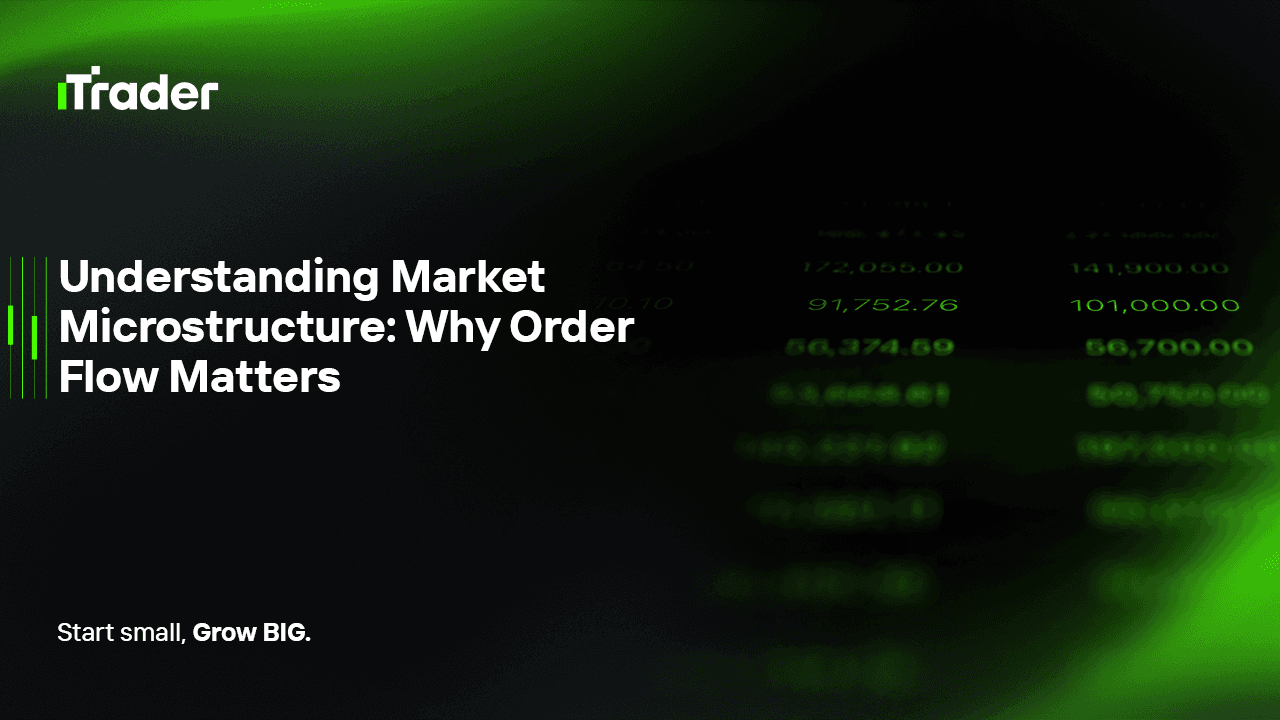2025-07-02
To the average trader, markets appear as a stream of prices moving up and down. But what causes those movements? What drives that next tick in the price of EUR/USD or S&P 500 futures?
The answer lies not in broad economic theory, but in the microstructure of the market—the mechanics that govern how orders are matched, how liquidity forms, and how information becomes priced in. At the center of this machinery is order flow: the detailed record of how buyers and sellers interact.

Understanding market microstructure and tracking order flow can provide traders with insights that traditional technical indicators simply cannot. Whether you’re trading manually or building an automated strategy, mastering this layer of market behavior is essential for precision and performance.
AI Summary:
What is market microstructure and why does order flow matter?
Market microstructure is the study of how financial markets operate at the transaction level, focusing on the mechanics behind trade execution, order types, liquidity, and price formation. Order flow refers to the real-time sequence of buy and sell orders and is a critical factor in understanding short-term price movements. By analyzing order flow, traders can identify institutional activity, assess market sentiment, and improve trade timing and execution. Understanding microstructure helps traders reduce slippage, interpret price action more effectively, and gain an edge in high-frequency or algorithmic trading strategies.
Market microstructure is the study of the processes and protocols through which trades are executed. It focuses on the real-time behavior of market participants and the infrastructure that facilitates price discovery.
Unlike macroeconomics, which asks why prices move, microstructure asks how they move—from the smallest change in a limit order book to the impact of execution speed.
Order flow is the net movement of buy and sell orders across the market. It reflects real-time sentiment and reveals which side—buyers or sellers—is more aggressive.
Every time a trade occurs, it represents a market order "hitting" a limit order resting in the book. For instance:
A consistent flow of aggressive buying or selling can push price in that direction—even without new information entering the market.
To understand microstructure, it’s essential to identify who’s placing the orders and why. Participants are not all equal—they have different motives, speeds, and strategies.
They provide liquidity by quoting both buy and sell prices, profiting from the bid-ask spread. They aim for frequent, low-risk trades.
These include hedge funds, mutual funds, and pension funds. They often split large orders into smaller chunks to avoid moving the market—a tactic called order slicing or iceberging.
Typically trade smaller sizes. Their impact on order flow is limited but can become significant in thin or fast markets.
HFT firms thrive on speed and microstructure inefficiencies. They use co-location and low-latency algorithms to anticipate short-term price shifts.
Price doesn't move just because of news or fundamentals—it moves when orders are executed. If buyers are more aggressive than sellers (i.e., market orders are lifting the ask), the price moves up.
This is why volume alone isn't enough—you must know whether the volume was executed on the bid or the ask. That directional intent is what gives order flow its predictive power.
Understanding microstructure and order flow can transform how you approach the market.
Rather than relying on lagging indicators, traders can observe real-time buyer/seller aggression to enter on confirmation, not prediction.
Watching where large passive orders rest in the book (and where they disappear) can reveal hidden support/resistance levels.
Unusual surges in one-sided order flow, iceberg orders, or spoofing patterns often hint at large player involvement.
Quantitative strategies that integrate order book dynamics and trade prints often outperform those based solely on price and volume.
These tools help traders make informed decisions in fast-moving markets, where milliseconds matter.
Many modern trading strategies—especially in prop trading firms—are built on microstructure principles.
While powerful, interpreting order flow isn’t without challenges:
As markets evolve, so do microstructure dynamics. Increasing automation, fragmentation (across multiple venues), and the rise of crypto markets are reshaping how order flow is interpreted.
New frontiers include:
For traders and firms that adapt, microstructure offers one of the clearest competitive advantages in the market.
In trading, timing is everything—and timing depends on structure. While most strategies operate at the macro or technical analysis level, it’s the microstructure that determines the fine print of success.
Order flow analysis gives traders the ability to see beneath the surface of candles and indicators, revealing the intent behind every price movement. By learning to read the market’s internal language, traders gain sharper entries, smarter exits, and the capacity to compete in the most data-driven segment of the financial world.
Whether you're developing an algorithm, executing manually, or running a prop desk, understanding market microstructure is no longer optional—it's foundational.
© 2025 iTrader Global Limited|公司註冊編號:15962
iTrader Global Limited 註冊於科摩羅聯盟昂儒昂自治島穆扎穆杜 Hamchako,並受科摩羅證券委員會授權與監管。我們的牌照編號為 L15962/ITGL。
iTrader Global Limited 以「iTrader」為商業名稱經營,獲得從事外匯交易活動之授權。公司標誌、商標與網站均為 iTrader Global Limited 之專有財產。
iTrader Global Limited 的其他子公司包括:iTrader Global Pty Ltd,澳洲公司註冊編號(ACN):686 857 198。該公司是 Opheleo Holdings Pty Ltd 的授權代表(澳洲金融服務代表編號:001315037),Opheleo 持有澳洲金融服務執照(AFSL 編號:000224485),註冊地址為:Level 1, 256 Rundle St, Adelaide, SA 5000。
免責聲明:本實體並非本網站所交易金融產品之發行者,亦不對其負責。
風險提示: 差價合約(CFD)交易因槓桿效應具高度資本迅速損失風險,未必適合所有使用者。
參與基金、差價合約及其他高槓桿商品交易,需具備專業知識。
研究顯示,84.01% 的槓桿交易者最終蒙受損失。請務必充分了解相關風險,並在投入資金前確保自身已準備好承擔全部損失的可能性。
iTrader 特此聲明,對任何個人或法人因槓桿交易所導致之風險、損失或其他損害,概不承擔全部責任。
使用限制: iTrader 並不向法律、法規或政策禁止此類活動的國家或地區居民提供網站或服務。如您居住於限制使用本網站或服務之司法管轄區,您有責任自行確保遵守當地法律。